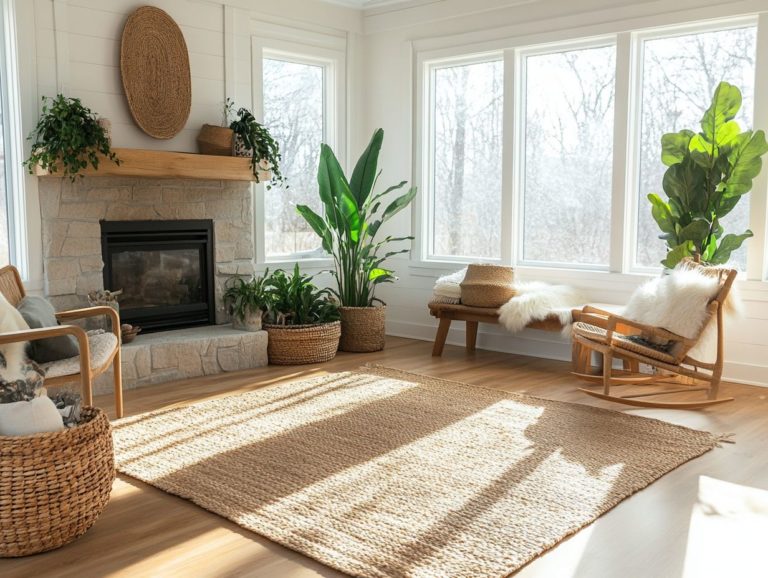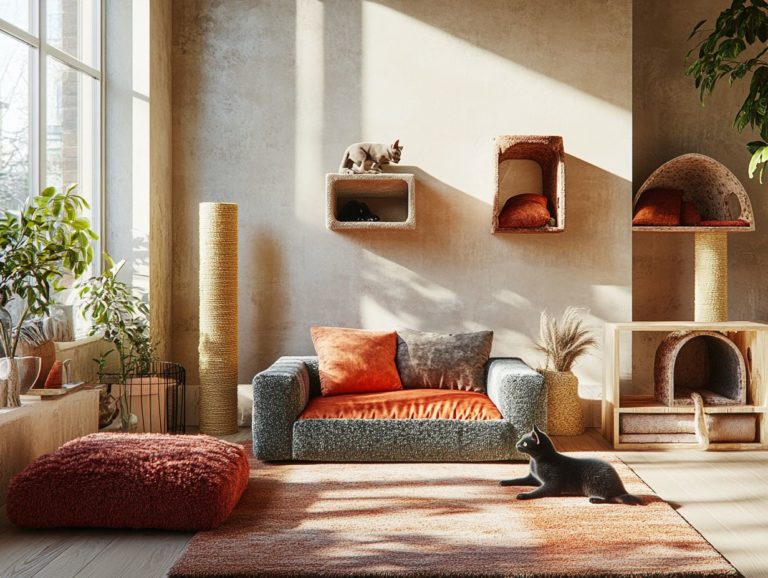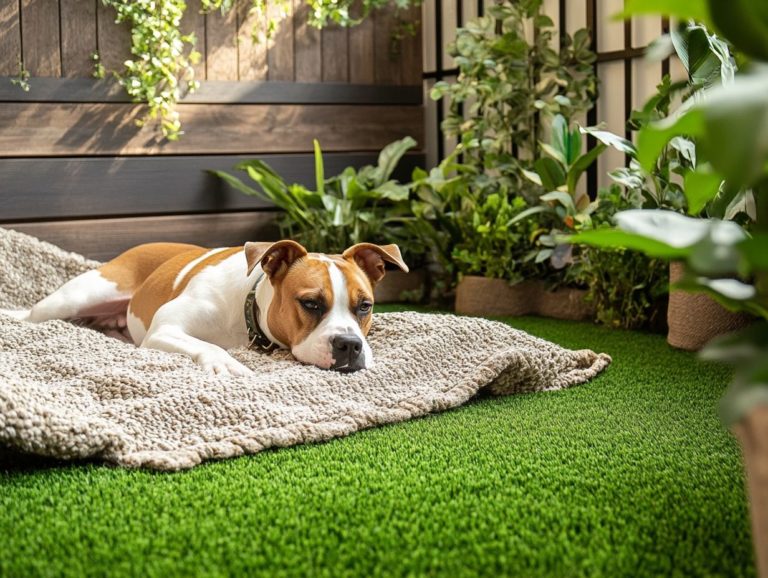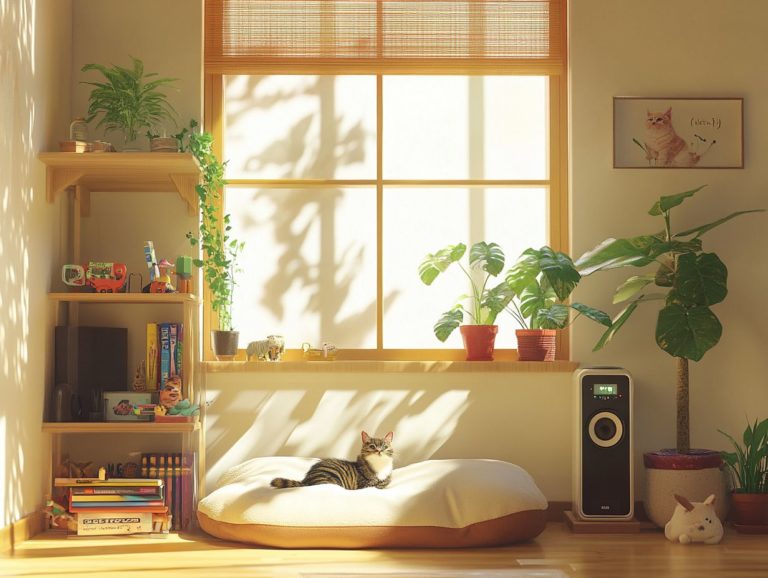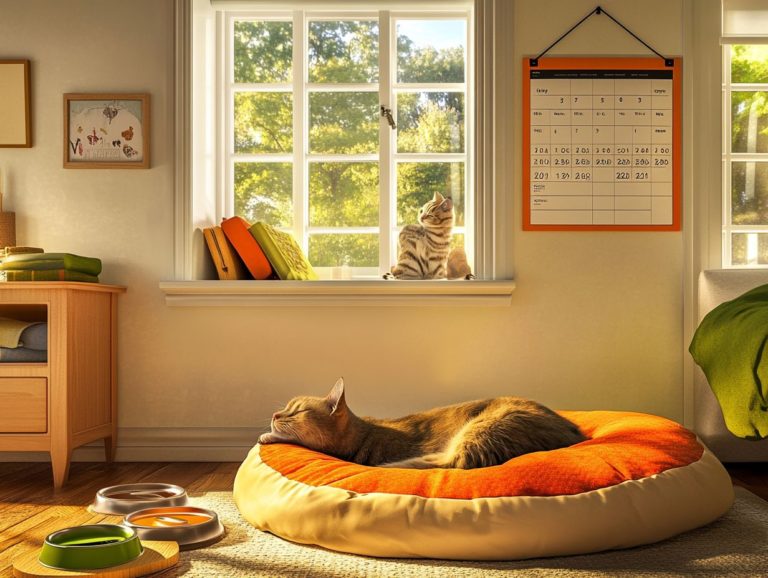Creating Multi-Sensory Environments for Pets
Creating a multi-sensory environment, such as a sensory yard or sensory garden, is an innovative way to improve your pet’s happiness and health.
These specially designed spaces engage your pet’s senses sight, sound, touch, and smell providing a rich experience that can enhance their quality of life and help with behavioral issues.
Discover what multi-sensory environments are, the countless benefits they provide, and how to create one tailored to your furry friend’s preferences, specifically for dogs.
From inviting outdoor setups to cozy indoor spaces, find practical tips to keep your pet engaged and happy, including using dog-safe herbs and chew toys.
Contents
- Key Takeaways:
- What Are Multi-Sensory Environments for Pets?
- The Benefits of Multi-Sensory Environments for Pets
- Creating a Multi-Sensory Environment for Your Pet
- Examples of Multi-Sensory Environments for Pets
- Tips for Maintaining a Multi-Sensory Environment for Pets
- Frequently Asked Questions
- What is a multi-sensory environment for pets?
- Why should I create a multi-sensory environment for my pet?
- What are some elements to include in a multi-sensory environment for pets?
- How do I create a multi-sensory environment for my pet?
- Can any pet benefit from a multi-sensory environment?
- Are there any risks to creating a multi-sensory environment for my pet?
Key Takeaways:
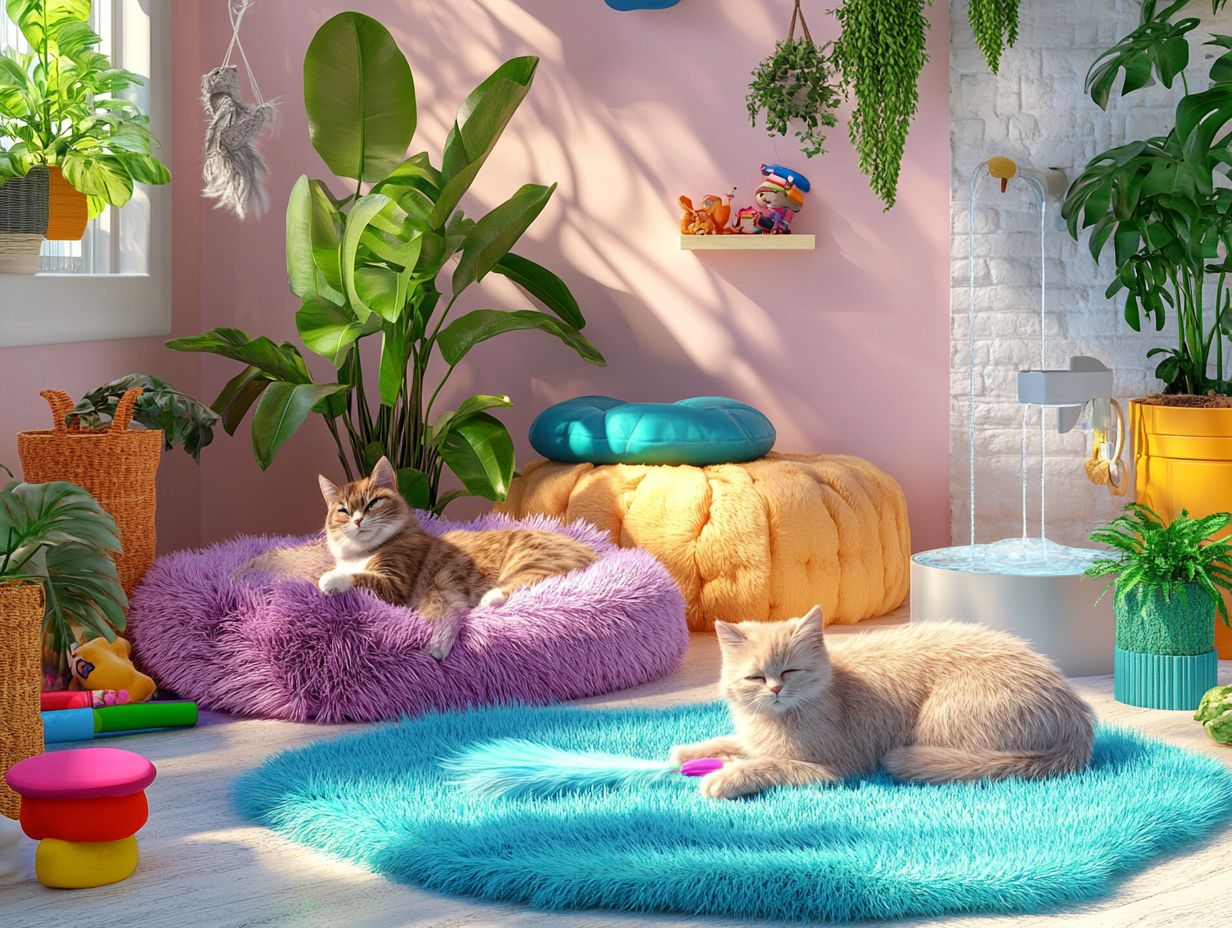
- Boost your pet’s happiness with a multi-sensory environment.
- Identify your pet’s preferences to choose the right elements for their space.
- Regularly update the environment to adapt to your pet’s changing needs.
What Are Multi-Sensory Environments for Pets?
Multi-sensory environments are designed to engage multiple senses at once, focusing on sight, sound, smell, taste, and touch to enrich your dog’s experience.
Imagine vibrant colors and varied textures that catch your dog’s eye and invite exploration. Soothing sounds, like gentle music or wind spinners, can create a calming atmosphere.
Incorporating aromatic, dog-safe herbs like lavender and mint adds a fragrant layer for them to sniff and enjoy. Mix these elements to create a space where your dog can explore and relax.
The Benefits of Multi-Sensory Environments for Pets
Multi-sensory environments offer numerous benefits, especially for dogs. By immersing them in varied stimuli, you enhance their well-being and promote positive behaviors.
Improving Quality of Life
Creating a multi-sensory environment can significantly elevate your dog’s quality of life by encouraging healthy behaviors through engaging sensory experiences. For more insights, check out this guide on creating a balanced environment for pets.
When dogs interact with diverse sensory experiences like different textures, scents, and sounds they’re more likely to display playful behavior. Research shows that natural scents like lavender can reduce anxiety in shelter dogs, leading to calmer temperaments.
Interactive toys that produce various sounds keep your dog mentally engaged, reducing boredom and destructive chewing. By including sensory-rich activities in your dog’s routine, you enhance their emotional well-being and encourage healthier lifestyle choices.
Don’t miss out on enriching your dog’s life start creating a multi-sensory environment today!
Addressing Behavioral Issues

Multi-sensory environments can transform how dogs behave. They provide enriching experiences that reduce anxiety through enhanced senses.
These spaces engage your dog’s senses sight, smell, touch, and sound. Imagine a sensory garden filled with soft grass, sand, rough bark, and smooth stones, inviting your dog to explore.
Adding fragrant plants or dog-safe herbs delights their sense of smell. This distraction helps them cope with things that might cause anxiety.
Guided play in these environments can reduce aggression and fear. This creates a calmer, more sociable companion.
Creating a Multi-Sensory Environment for Your Pet
Creating a multi-sensory environment for your pet requires a focused approach. It involves designing a home environment for anxious pets that meets their unique preferences.
Identifying Your Pet’s Sensory Preferences
Identifying your pet’s sensory preferences is vital for effective enrichment. Observe how your dog interacts with different sounds, textures, and sights.
For example, some dogs wag their tails when they feel soft fabrics. Others might perk up at the sound of squeaky toys or certain music.
Engaging in activities like scent trails or nature snuffles reveals what captivates your dog’s attention. This approach enriches their daily experiences and strengthens your bond.
Choosing the Right Elements for Your Pet’s Environment
Choosing the right elements is crucial for an effective sensory garden. Include dog-safe herbs, interactive water features, and safe chew toys.
Your space can become a vibrant paradise that excites all of your pet’s senses. Picture bright plants like Lilac and Columbine inviting your curious pet to take a closer look.
Include gentle water sounds for a calming effect. Adding tasty dog-safe herbs like basil or parsley can enhance their senses and offer health benefits.
By thoughtfully selecting these elements, you create a balanced sensory experience for your furry friend.
Examples of Multi-Sensory Environments for Pets
Explore various examples of multi-sensory environments for pets. These outdoor and indoor settings show how diverse sensory stimuli can enhance your dog’s experience.
As a final step, consider creating your own multi-sensory environment. Your pet will thank you for it!
Outdoor Spaces

Outdoor spaces, such as sensory gardens, can greatly enhance your dog’s experience by introducing elements like diverse plant life, interactive water features, and engaging nature snuffle activities.
These environments aren t just a visual treat; they also stimulate your dog s instinctive behaviors through positive stimulation. Take fragrant plants like lavender and mint. They invite your canine companion to explore their surroundings through delightful scents, promoting smell exploration.
Play areas with textured surfaces, whether it s sand or soft grass, elevate tactile experiences. Your dog can dig, roll, and frolic to their heart’s content, enhancing overall enrichment experiences.
Gentle water features can spark water play, offering a refreshing escape. Scattered toys and hidden treats throughout the garden present exciting challenges that foster mental stimulation and sharpen problem-solving skills, ensuring a fulfilling environment for your dogs.
Indoor Spaces
Indoor spaces can be transformed into captivating multi-sensory environments for dogs, where sensory gardens and chew toys blend seamlessly with auditory stimulation, crafting an engaging atmosphere for effective enrichment.
Thoughtfully curating vibrant colors for walls and furnishings amplifies visual engagement. This creates an inviting ambiance that truly captivates your canine companion.
Gentle sounds, like soothing music or the whispers of nature, can promote relaxation. A variety of textures, from soft blankets to textured scratching posts, offer delightful tactile experiences that your dog will adore.
Add aromatherapy diffusers to boost sensory interaction by releasing pleasant scents that create a relaxing and enjoyable space. You might even consider integrating play areas designed for interactive toys. These stimulate curiosity and physical activity through positive feedback, ensuring that your dog’s indoor experience is both enriching and harmonious.
Tips for Maintaining a Multi-Sensory Environment for Pets
Maintaining a multi-sensory environment for your pets necessitates regular assessment and thoughtful adaptation. This approach ensures they receive consistent positive stimulation and enrichment, which enhances their overall well-being and happiness.
Regularly Assessing and Adapting the Environment
Regularly assessing and adapting your pet s environment is essential for providing continuous sensory stimulation and enrichment that aligns with their evolving needs. This thoughtful process enhances their well-being and deepens the bond between you and your furry companion.
To begin, observe your pet s reactions to various stimuli sounds, textures, and scents. Take note of what sparks their positive engagement. Incorporating tools like sensory mats or interactive toys can help you understand what truly ignites their curiosity.
Re-evaluating the layout of their space by introducing or rearranging elements think plants, cozy hiding spots, or a snug nook can significantly influence their exploration patterns. By making regular updates based on these assessments, you create a richer, more inviting environment that caters to their distinct preferences and behavioral cues.
Frequently Asked Questions
What is a multi-sensory environment for pets?
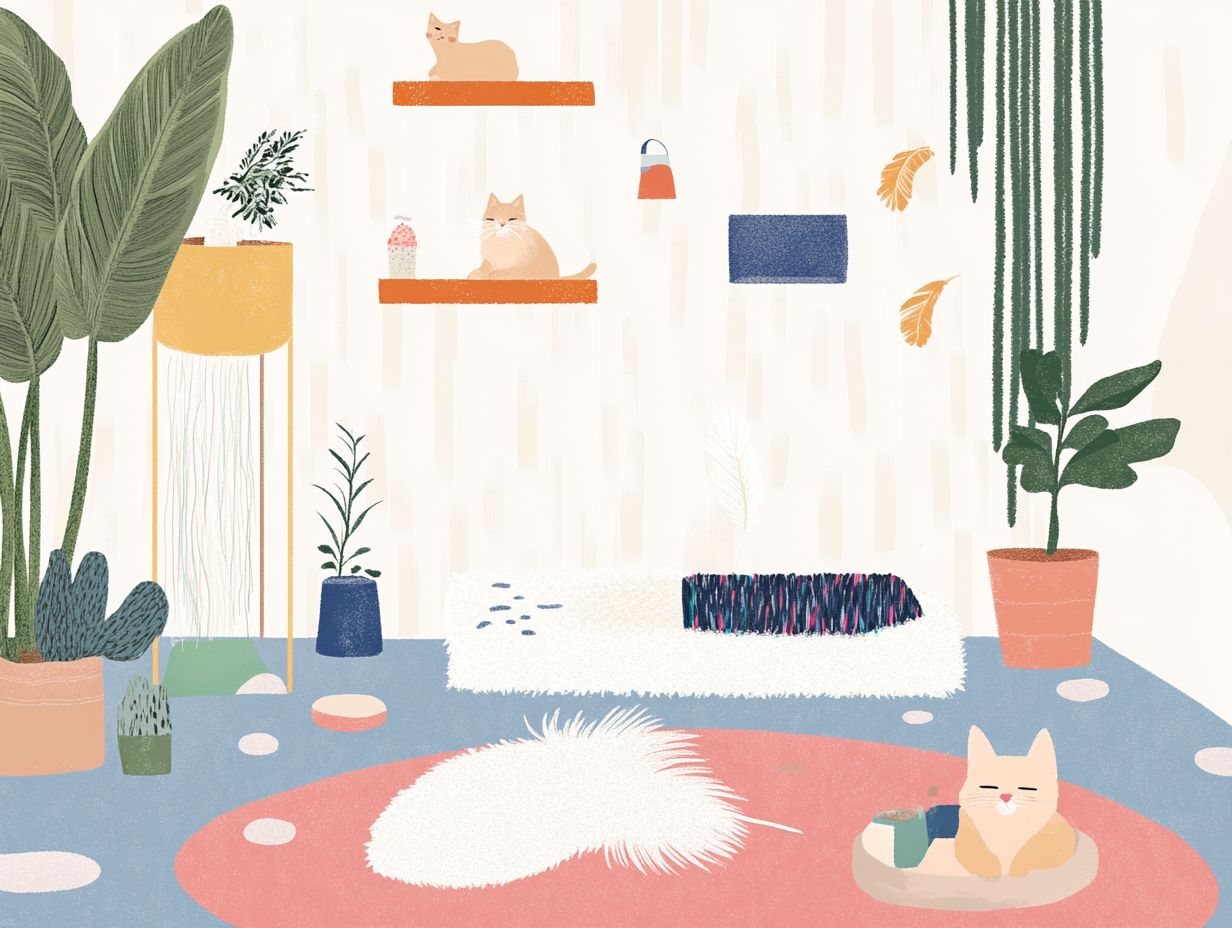
A multi-sensory environment for pets is an area specifically designed to stimulate and engage a pet’s senses, including sight, sound, touch, and smell. For more insights, check out these tips for creating sensory gardens for pets, which are meant to create a relaxing and enjoyable experience for the pet.
Why should I create a multi-sensory environment for my pet?
Multi-sensory environments have been shown to improve a pet’s overall well-being and reduce anxiety and stress. They provide mental and physical stimulation for pets, which is important for their overall health and happiness.
So, why not start creating a multi-sensory environment for your pet today?
What are some elements to include in a multi-sensory environment for pets?
Include natural materials, interactive toys, soothing sounds, and pleasant scents. Tailor the setup to your pet s unique needs and preferences.
How do I create a multi-sensory environment for my pet?
Start by choosing a spot in your home for your pet. Add soft blankets, interactive toys, and calming scents.
Can any pet benefit from a multi-sensory environment?
Absolutely! Every pet can gain from such an environment. Just remember to consider their individual sensitivities.
Are there any risks to creating a multi-sensory environment for my pet?
There can be risks when introducing a new environment. Keep an eye on your pet s reactions and adjust the elements as needed.


